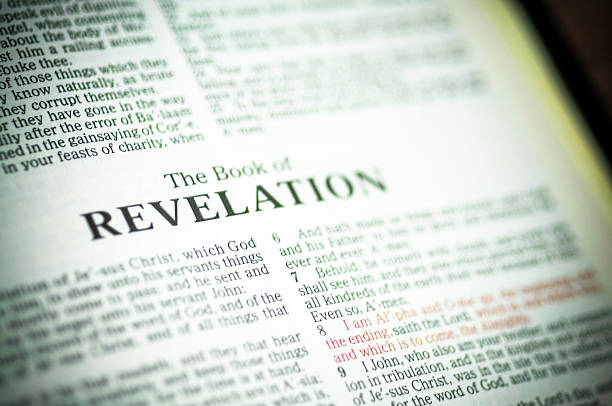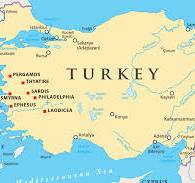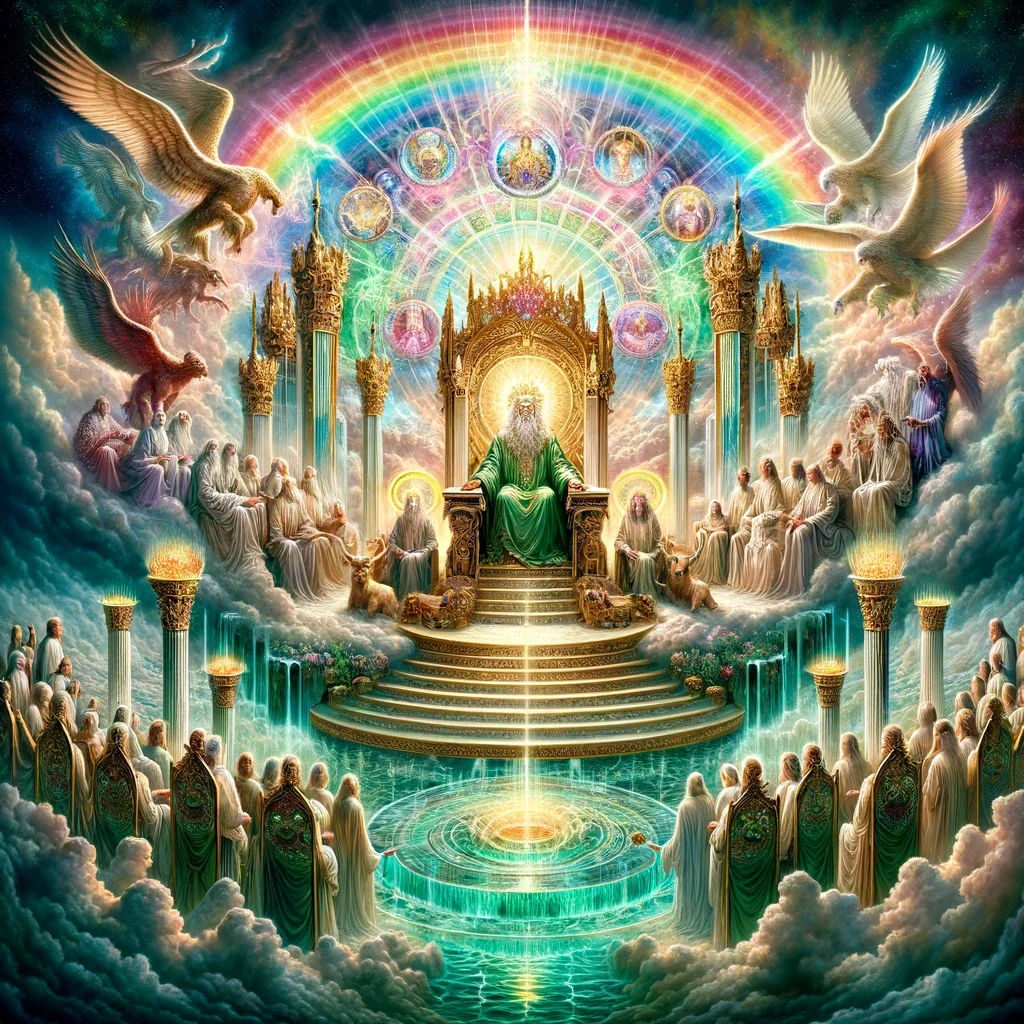

Revelation
The book of Revelation can be straightforward for some, yet puzzling for others. Over the past year, I’ve studied Revelation deeply, working through it chapter by chapter. My approach is rooted in how I interpret Scripture by studying the Bible and reading commentaries and books by men of God trust.
I firmly believe that everyone should read Revelation. Once you’ve grasped its message about the future and the end times, you’ll feel a compelling urgency to seek God and share with others the fate of the lost—showing them why we all desperately need a Savior.
(scroll down or hit Control F, to locate the chapter you need).
The Book of Revelation
Chapters 1-3
In the first three chapters of Revelation, we encounter a wealth of symbolism that underscores the profound significance of the number seven within the Bible. This number, intricately woven throughout scripture, finds its most prominent mention within the Book of Revelation. As we study into the text, we uncover the deep-rooted importance of the number seven within the visions revealed to John.
Revelation 1:12-17 opens with a powerful encounter between Jesus and John, where Jesus instructs him to document the visions set to unfold. These messages, destined for the seven churches in Asia Minor, are emblematic of Ephesus, Smyrna, Pergamum, Thyatira, Sardis, Philadelphia, and Laodicea. Jesus, within the vision, stands with seven golden lampstands—a symbolic representation of these churches—and clutches seven stars, meaning the pastors or angels of each congregation. The lampstands, symbolizing the spiritual state of the churches, stand as a testament to their worthiness of being illuminated by God’s presence. The number seven, as consistently seen in scripture, imparts profound symbolic significance. This vision conveys a message of both judgment and hope, predicting the victory of goodness over evil and the ultimate elimination of sin, including the overthrow of Satan and his followers.
Further along in Revelation 1:12-16, John vividly depicts the glorified Jesus Christ through seven symbolic descriptions. Jesus is in a robe with a golden sash, Jesus epitomizes authority and dignity just like a high priest or king. His hair, as white wool, symbolizes purity, holiness, and eternal wisdom rather than age. His fiery gaze alludes to divine insight, judgment, and omniscience, while His feet of burnished bronze represent strength, stability, and purity of judgment. Jesus’ voice, resonant as the roar of many waters, denotes power, authority, and majesty. Holding the seven stars in His hand, Christ symbolizes His watchful care and control over His followers, while His face, radiant as the sun in full strength, exudes divine glory and splendor.
In Chapter 2, Jesus imparts wisdom to John regarding the spiritual standing of each church, ranging from strength to weakness. Addressing the ‘angels’ or pastors of these congregations, His messages bear relevance and admonition for contemporary believers. These churches, diverse in their spiritual conditions, mirror facets of our individual journeys with God, underscoring the need for vigilance and adherence to spiritual truths elucidated within Revelation’s profound narrative.

Letters to the Seven Churches
- The Church of Ephesus, known as the ‘Loveless’ Church in Revelations 2:1-7, holds great significance in the Christian faith. Founded by the apostle Paul and continued by John after Paul’s execution, this church was situated in a vibrant and bustling city with a rich cultural and political landscape. Ephesus was a city filled with grand buildings, theaters, and boasted the third-largest library in the ancient world. The presence of the temple of Artemis, one of the Seven Wonders of the Ancient World, added to the city’s allure. Despite being a hub for travelers from diverse cultures and beliefs, Ephesus was the perfect place for the Gospel to be spread. The letter to the church in Ephesus commends their perseverance and suffering for Jesus but also highlights a crucial flaw – they had forsaken their first love in Christ. This spiritual decline mirrored the city’s own downfall, which saw a decrease in population and prestige over time. Paul’s ministry in Ephesus was marked by a struggle against sinful activities like witchcraft and pagan worship. The conversion of many to Christianity led to economic disruptions and even riots, showing the impact of the Gospel in this city. Ultimately, the story of Ephesus serves as a powerful lesson for believers today. It reminds us of the importance of maintaining our passion and devotion for Christ, even in the face of challenges and distractions. Just like the Church of Ephesus, we are called to rekindle our first love for Jesus and keep the fire of faith burning bright.
2. The Church of Smyrna, known as the ‘Persecuted’ Church in Revelations 2:8-11, faced intense persecution even amidst a bustling and intellectual city. Jesus acknowledged their hardships and encouraged them to remain steadfast, promising the crown of life for their faithfulness. The historical background of persecution, including the martyrdom of Christians during Emperor Nero’s rule, serves as a powerful reminder of the ultimate hope believers have in Christ. The story of Bishop Polycarp, who chose to die rather than renounce his faith, exemplifies the unwavering devotion of early Christians in the face of persecution. Despite the challenges, Jesus reassures us that suffering is temporary, but the reward of eternal life is everlasting. This serves as a poignant lesson for all believers to endure hardships with faith and courage, knowing that ultimately, death will not have the final victory.
3. The Church of Pergamos, known as the ‘Compromising’ Church in Revelation 2:12-17, was situated in a city heavily influenced by paganism and occult practices. The worship of false gods, including Asclepius symbolized by a snake, and the presence of temples for Zeus, created a challenging environment for Christians. The city was known for its wealth and grand architecture but also for its dark associations with Satan’s power. The martyrdom of Antipas, burned alive in a metal bowl, exemplifies the extreme persecution faced by believers in this dangerous city.
Emperor Nero’s hatred towards Christians and his satanic priests who sought their destruction added to the city’s hostility. Christians were pressured to renounce their faith and worship Nero, facing death if they refused. The church in Pergamos was reprimanded by Jesus for compromising their beliefs and embracing the ungodly practices of the society around them.
Today, many churches around the world still face persecution and destruction for proclaiming Christ. The lesson from Pergamos church remains relevant – believers are cautioned against blending with the sinful world and urged to repent from compromising their values. The call is to remain separate from worldly influences, standing firm in faith and resisting the allure of compromising beliefs.
4. The Church of Thyatira, known as the ‘Corrupt’ Church in Revelations 2:18-29, initially receives praise for its love, faithfulness, and service. However, John’s tone quickly shifts as he addresses the presence of Jezebel within the church, engaging in idol worship, prostitution, and other evil actions. Jezebel, though not her real name, symbolizes the wicked woman from the Old Testament who sought to lead people away from God.
Just like the Jezebel of old, the figure in the Thyatira church led Christians into idol worship and immorality, working against God’s teachings. This cautionary tale remains relevant today, as we are surrounded by a culture that promotes sexual immorality through various media.
Jesus offers a chance for repentance, but those who choose not to change their ways will face consequences. John urges the church to stand firm against compromising their beliefs and to be on guard against false prophets. The core message of the letter to Thyatira is a reminder that God requires purity and holiness in His church and in our lives.
5. The Church of Sardis, known as the “Dead or Sleeping” Church in Revelations 3:1-6, had a reputation for being alive but, in reality, was spiritually dead. Jesus warns them to wake up and repent, or else he will come upon them like a thief in the night. Despite not facing false teaching or persecution, the church was lacking in joy, fruitfulness, growth, and productivity. They were merely going through the motions of faith, much like many churches today that focus on rituals rather than a personal relationship with God. The main message for the church of Sardis, and for today’s church, is to “Wake up” and seek a vibrant, living relationship with God.
6. The Church of Philadelphia, often referred to as the “Faithful” Church in Revelations 3:7-13, may have been small in size, as indicated by their “little strength” mentioned in verse 8. Despite their humble stature, they remained steadfast in keeping God’s Word and never denied Him. Located in what is now known as Alasehir, a town 45 miles from Sardis, Philadelphia was historically a small and unremarkable city compared to others in the region. Known for its agricultural focus on grape and raisin cultivation, the city was prone to earthquakes, still offering hospitality and embodying the meaning of ‘brotherly love.’
The city had faced devastation from a major earthquake prior to John’s writing of Revelations. Emperor assistance and tax exemption for rebuilding efforts helped the Philadelphians recover and return to the city. This act of rebuilding symbolizes the need to rebuild and find strength through God during life’s challenges. The church in Philadelphia was viewed as being on stable foundations due to their unwavering faith in Christ.
Jesus promises the church in Philadelphia protection from the upcoming trial due to their faithfulness. They will be victorious, becoming a pillar in God’s temple with their names inscribed in the heavenly Jerusalem. This promise serves as a humbling reminder of the eternal blessings awaiting those who remain faithful to God, regardless of their size or status. The key lesson from the Church of Philadelphia is that faithfulness to God and His work leads to everlasting rewards.
7. The Church of Laodicea, known as the “Lukewarm” Church in Revelation 3:14-22, was situated in a city known for its wealth, fertile lands, and advanced medical and banking centers. Despite their material prosperity, the church had lost its fervor for Christ, leading Jesus to criticize them for being neither hot nor cold. The lukewarm attitude of the church mirrored the tepid taste of the local water supply, causing Jesus to warn them of being spit out of His mouth.
The self-sufficient and proud nature of the city reflected in the church’s lack of enthusiasm, commitment, and righteousness. Jesus urged them to repent and return to a genuine relationship with Him, emphasizing the need to prioritize eternal values over material possessions. The lukewarm condition of the church symbolized a spiritual complacency that needed to be addressed.
Just as Laodicea faced the repercussions of their self-reliance, Jesus offered them a chance to open the door of their hearts to Him. By allowing Him in, they could restore their relationship with God and experience true fellowship.
Conclusion
The messages to the seven churches, including Laodicea, serve as reminders to repent, turn from sin, and cultivate a genuine relationship with Christ. Through faithfulness and perseverance, followers can overcome challenges and receive the promises of eternal life, ultimately leading to the defeat of sin and the fulfillment of God’s perfect will.
Chapter 4
The Call to Heaven (Revelation 4:1-2)

The chapter unfolds with John hearing a voice akin to a trumpet, beckoning him to ascend to witness what follows the messages to the churches (Revelation 4:1). This voice guides John beyond the earthly realm into a spiritual vision of heavenly truths, urging him to observe the events God reveals. Being ‘in the Spirit’ (Revelation 4:2) indicates a spiritual transport for John, enabling him to perceive things beyond the physical world, entering a divine revelation unlike any seen before. The shift between chapters 3 and 4 signifies the rapture occurring, with all Christians in Heaven, as the focus shifts away from the church age to Heaven. The vision of God’s throne (Revelation 4:3-6) is described with marvelous brilliance shining like precious stones symbolizing purity, power, and majesty (Revelation 4:3). Surrounding the throne, a rainbow resembling emerald signifies God’s covenant faithfulness and mercy, bringing peace and tranquility. Alongside the throne, 24 elders dressed in white and golden crowns represent post-raptured Christians receiving rewards for their earthly deeds, symbolizing purity, victory, and honor bestowed by God. The throne’s sea of glass reflects God’s holiness, bringing order and peace to the universe. The presentation of the four living creatures (Revelation 4:6-8) speaks to vigilance and awareness of God’s will and activity, symbolizing different aspects of creation, united in acknowledging God’s glory and holiness. Their perpetual chant praises the Lord God Almighty’s holiness and eternal nature, acknowledging His sublime supremacy. The elders’ worship (Revelation 4:9-11) exemplifies eternal adoration and submission to God’s glory, recognizing that all honor and power belong to the Creator alone. Heavenly worship reflects God’s sovereignty, divine holiness, eternal worship, and the purpose of creation, emphasizing a continuous praise to the Creator of all things. Revelation Chapter 4 offers a heavenly insight into God’s sovereign reign, holiness, and the eternal worship attributable to His supremacy. The chapter inspires believers to align their lives with God’s supreme authority, acknowledging and worshiping Him as the essence of creation.
Chapter 5
As the story unfolds in Revelation 5, the scene shifts to the Worthy Lamb who opens the divine scroll, symbolizing the redemptive and judgmental divine plan. The following verses depict Christ as both the conquering King and sacrificial Redeemer, symbolized by the Lion and the Lamb, respectively. The Lamb’s unique worthiness to execute God’s redemptive plan underscores His obedience and sacrifice, prompting all of heaven to erupt in worship and recognition of His merit. Revelation 5 emphasizes Jesus Christ as the sole bridge between God and humanity, inviting believers to worship the Lamb who secured and fulfilled God’s eternal plan. This chapter signifies that only Christ, with His sacrifice, embodies the hope and salvation for the world, deserving eternal honor, glory, and power.
